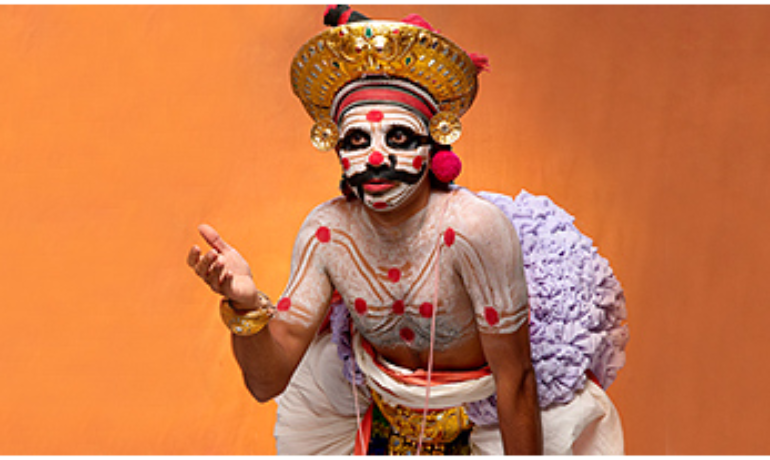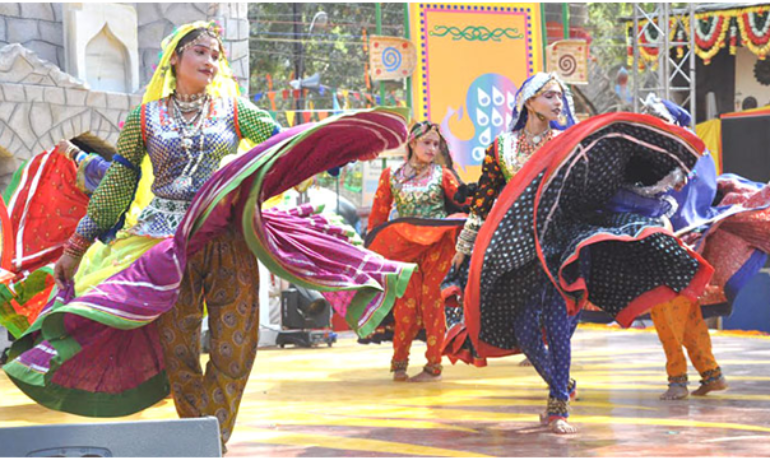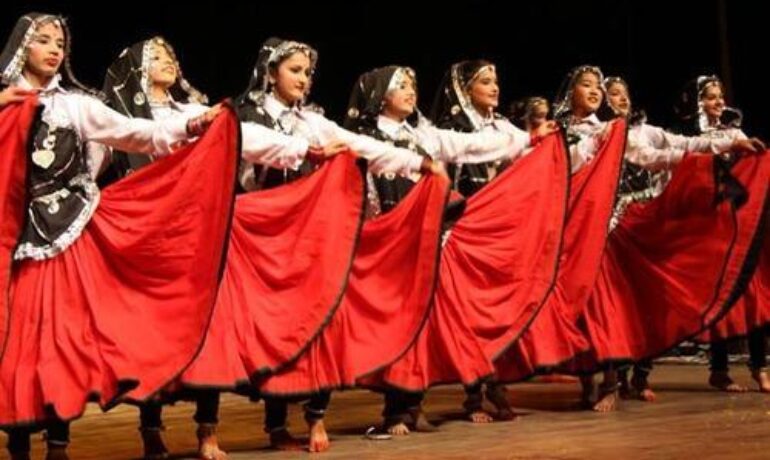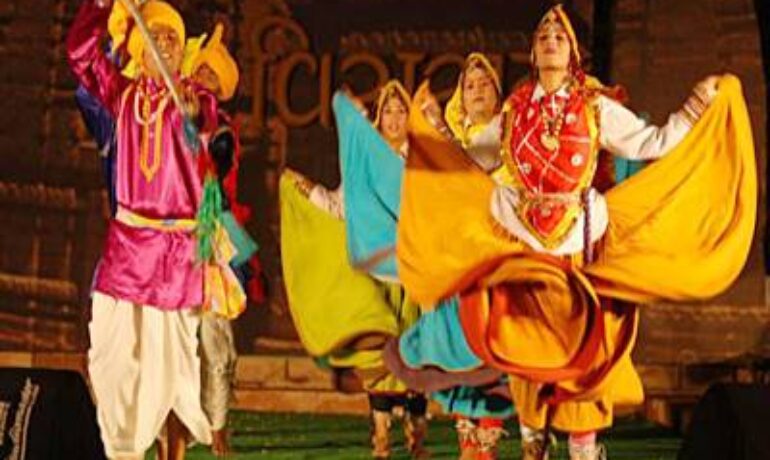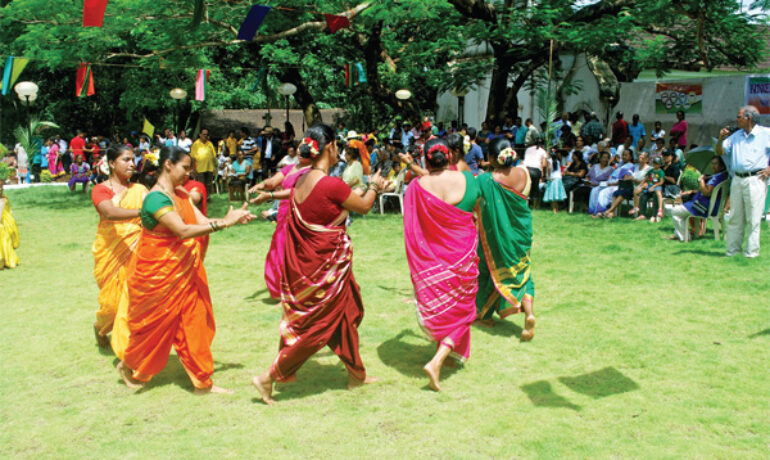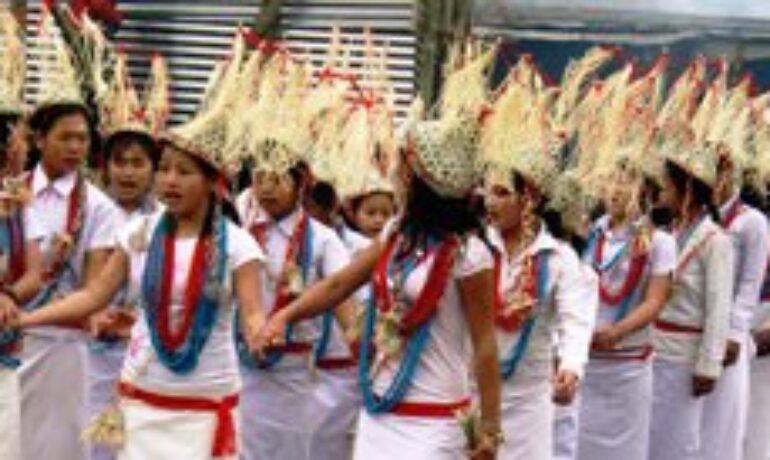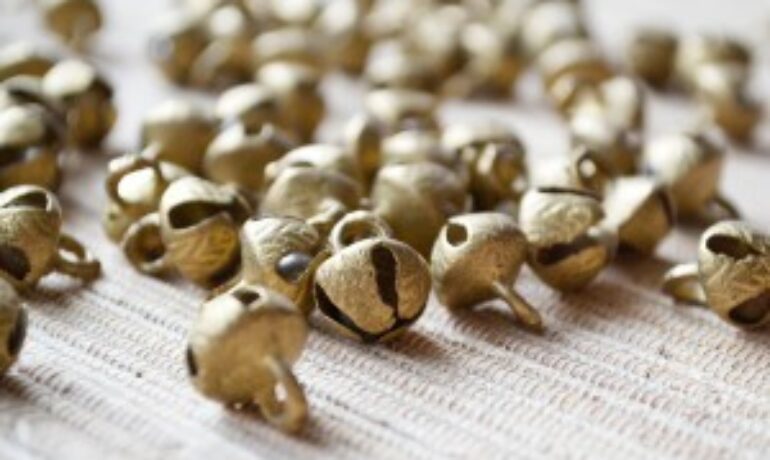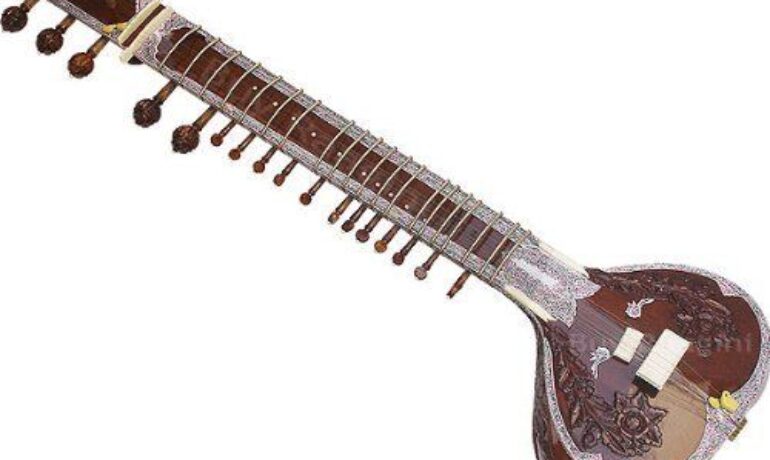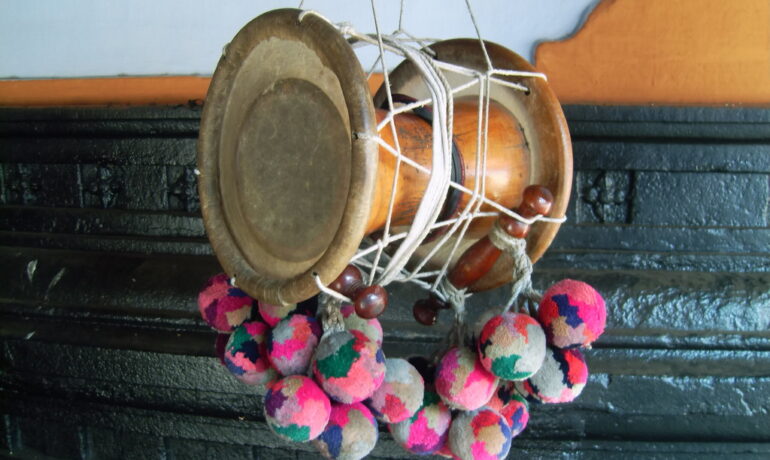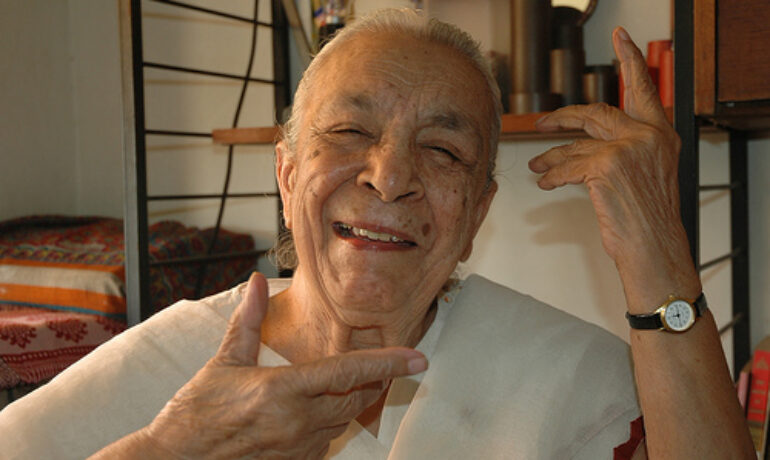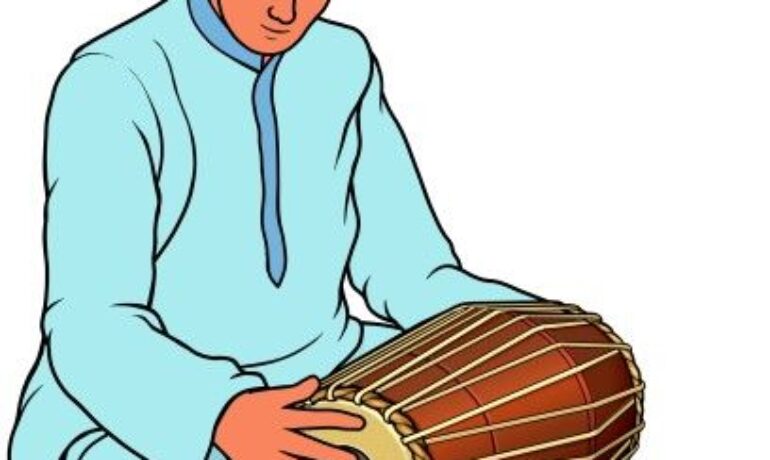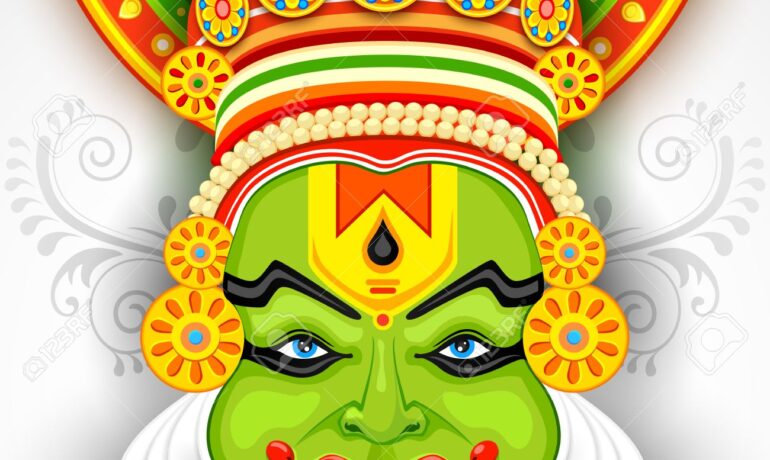The Rocking Instrument- Sursringar Another form of Seniya Rabab is Sursringar. There are a few limitations to the rabab. The been has an advantage over rabab as the gut strings and skin parchment which are upon the resonator in the rabab slowed down the Alapchari. The sound of the rabab deteriorates due to the […]
Read MoreWhat is Esraj? The Indian bowed instrument also called ‘esraj’, is well known with the name ‘Tar Shehnai’. The metal horn that is attached to its soundboard amplifies the sound. Sometimes, the horn of a phonograph is used in the instrument. The sounds produced by a violin and Shehnai (instrument of India) are similar to […]
Read MoreOrigin With the spread of Christianity, Chavittu Natakam, one of a colorful theatre form flourished at Kodunngalloor in Kerala. This dance form had been introduced by the Portuguese. The originators of this art form are Chinna Thampi Pilla and Vedanayakan Pilla. The Effect of western visual opera can be clearly depicted through this art form. […]
Read MoreOttamthullal is said to be another version of Kathakali and known to be ‘Poor mans’ Kathakali’. A Person named Kunchan Nambiar had created this art form as a medium to protest against the socio-political structure and societal prejudice. They are performed in the Kerala temples. This dance form hails in all its glory till this […]
Read MoreHistory of the dance Mohiniattam has evolved from the state of Kerala, India. It is an Indian classical dance form as popular as Kathakali. Mohiniattam’s roots are derived from the ancient Sanskrit Hindu text ‘Natya Shastra’ which means performing arts. Mohiniattam is connected to Lasya which is more graceful and showcases a gentle and feminine […]
Read MoreOverview The Aryan Immigrants introduced this dance to Kerala. It is performed by the Chakiar caste members. The Hindus of the higher castes only can witness this highly orthodox entertainment. Koothambalam is the theatre in the temples where this dance is performed. The dance With elaborate hand gestures and dramatic facial expressions, the story is […]
Read MoreDance In this dance, the performers show their love for the almighty by dancing and singing. In the months of Karthika and Sharavana, the Hindu god is praised through performing this dance. The Hindu God Veerbhadra is praised throughout the Veeragase dance in the state of Karnataka. The singers, musicians, and dancers comprise the […]
Read MoreOverview on the Dollu Kunitha Dance One of the most popular drum dances of Karnataka occupying the proudest place among folk dances is – Dollu Kunitha. In this dance form, one sings and also displays spectacular varieties and complex skills for demonstration. History It is believed that Lord Beereshwara’s worshipper named Kuruba Gowdas had […]
Read MoreOverview In the district of Karnataka, Uttara Kannada, the Lion Dance named Simha Nrutya is very famous. The Yakshagana artists perform the dance by replicating the movements of a lion. The artists dress up like a lion wearing costumes made of bark and yarn which is colored with natural dyes […]
Read MoreBayalata Dance The well versed and creative people of southern Karnataka know different dance forms, and the Bayalata dance is widely enjoyed by them. Yakshagana is also another form of Bayalata. The Puranas and the epic poetries are also included in this dance because through this dance many mythological stories and poetries. The performers dance […]
Read MoreThe people of Central and Eastern India celebrate the festival of Karma every year. This is also called the Karma Naach or the Karma Dance. This dance is celebrated in the autumn season that means from the eleventh day of the fortnight of the month of Bhadrab. This dance called Karma Nach […]
Read MoreThe Kanjar tribe performs one of the most popular folk dances named Chakri. In Hindi, the word Chakri means Chakkar which means Circular rotation. The Kota and Baran districts of Rajasthan is inhabited by the Kanjar tribe. In the Haroti region of Rajasthan, Chakri dance is commonly performed in marriage celebrations and festivals. This tribal […]
Read MoreRouf Dance – Jammu & Kashmir What is Rouf Dance? The Rouf dance is a mystical poetical folk dance that is practiced by the women of the Kashmir valley. Among the several other dances in Kashmir, This dance is characterized by the women lining up in two rows facing each other in colorful costumes. This […]
Read MoreHikat, danced by women, is a modification of a game played by children. Forming pairs, the participants extend their arms to the front gripping each other’s wrists and with the body inclined back, go round and round at the same spot. A game played by children is modified and named ‘Hikat’ which is […]
Read MoreOne of the extravagant dances of the land of Punjab is popularly known as Giddha-a folk dance of women. This dance includes the rustic energy seen in the Bhangra dance. Giddha is one of the ancient dances of India which is known as the ring dance. this dance showcases feminity gracefully with a lot of […]
Read MoreLuddi dance is performed to celebrate the victory, it is basically performed by males. The steps are simple and slow and it is a mash-up of Bhangra. There is no discretion of gender while performing the dance as it is an enjoyable moment for all the ones celebrating victory. The Luddi dance, though colorful, doesn’t […]
Read MoreHistory In the beginning of the Mahabharata period, this dance called Dhamaal had originated in Haryana. The Ahirs (a tribe) in the Gurgaon area are famous for performing this dance. In the month of Phalgun, the men perform this dance in the moonlight. Along with the rhythm of the Dhamal, the men sing and dance. […]
Read MoreThe Loor is a dance form famous in the region of Bangar in Haryana. It is performed by the female dancers during the Holi festival. In this performance, the girls stand in a semicircular fashion and face each other. The first group sings the song and the other group replies to it. The first group […]
Read MoreAbout the dance Gugga Pir is worshiped as he is considered as a saint by the Hindu and Muslim folks residing in Haryana. The devotees of Gugga sing and dance worshiping Gugga saint during a procession a week before the Gugga Naumi. The procession is characterised by the Gugga dance. Using the instruments like the […]
Read MoreOverview One of the most popular dances of Haryana is the Khoria dance which is a little similar to the Jhumar dance. It is performed by the women folk in central Haryana. One of the striking features of this dance it is the fastest dance among all the others. For the occasions like weddings or […]
Read MoreThe Saang or Swang is a very popular dance form in the state of Haryana. This dance is a regional folkdance in many states like Rajasthan, Madhya Pradesh and Uttar Pradesh. This special folk dance Theme of this dance depends on the Hindu mythology. This beautiful dance form emerged form the Malwa region. This dance […]
Read MoreThe Dhalo festival is performed gracefully by the woman. As the earth has the ability to regenerate herself, this festival is based on the fertility. In this type of dance the heap of mud is the considered holy and it is worshipped as it symbolises the mother earth. This heap of mud is known […]
Read MoreTaranga Mel is a famous folk dance performed by the young generation of Goa, this is an energetic dance performed on Dushehra and Holi even on the Shigmo festival .The name ‘Tarangmel’ is derived from the streamers and flags which are called as Tarang. The multicolored flags as well as streamers are waved by the performers […]
Read MoreDekhni is a very popular dance of Goa which represents a blend of Indian melody with the tangy Western rhythm. The Dekni or Dekhni dance of Goa is usually performed by the Christian girls who dress up in beautiful Indian attires. The performance includes singing as well as dancing. In this particular dance, the life […]
Read MoreThe Konkani dance Fugdi is performed by the Goan women. The dance is performed on special occasions like Vrata, Ganesh Chathurthhi etc. The women of Goa take a break from their regular chores and have fun through dancing. This takes place in the month of the Bhaadrapa. The Dhangar community also known as the shepherds […]
Read MoreThe Dandiya Raas is a special traditional dance performed in honour of the Goddess Durga. It commemorates the victory of the Goddess over the evil Mahishasura. The dandiya represents the sword. The scenes of the battle are enacted and re-created. The audience witness the battle between Devi and demon in awe. This awesome dance is […]
Read MoreThe Yadavas (a caste considered as descendants of Krishna) perform the Raut Nacha. At the time of ‘devudhni ekadashi’, this dance is performed to worship Lord Krishna. This dance which has a close resemblance to the Raas Lela, is considered to be performed at a time which is known to be the awakening time of […]
Read MoreOverview The Satnami Comunity of Chattisgarh observes the most important ritual through a folk dance known as the Panthi dance. The dance involves a lot of gestures and expressions also rhythmic steps along the melodious songs History The tribes of the Chattisgarh state perform this dance which is full of cultural heritage and traditions. The […]
Read More“BIDESIA” – THE FOLK THEATRE OF EASTERN INDIA In the twentieth century of the emergence of the folk theatre, the dance form that is popularly known as ‘Bidesia’ in the state of Bihar had evolved. The theme of Bidesia rests on many topics which are related to the social structure of the community as well […]
Read MoreFAGUNA OR FAG DANCE This fantabulous dance is performed by the people in Haryana. The dance is perfomed in the Lunar month of Phalgun. The festival of colours which is popularly known as Holi is celebrated in this month. The musical instruments used for this dance is Tasha, Nagara and the Dhol. The songs of […]
Read MoreThe Lambadi is a folk dance among the Banjara which has originated from a village of Anupu. The land of Andhra Pradesh and Telangana are famous for having different folk dances with a varied culture of their own. Even they have their own dances, musical instruments etc. The Lambadis are basically nomads who move from […]
Read MoreThe Jatra is a dance that originated in West Bengal and also in Orissa. It is popular in the States of Bihar as well as it has a vivid music form and the theatre draws in the stories from several sources including the Hindu mythology, the popular legends and the realistic events. It is […]
Read MoreThe Manipuri dance arose from a small region which is covered with hills giving you a geographical solitude. The Manipuri dance originated from rich tradition and cultural background from the region of Manipur a place in North Eastern State of India that is surrounded by hills on all sides. King BhagyaChandra designed the dance […]
Read MoreYakshagana refers to old Sanskrit literature. It is very popular form of theatre combining energetic dancing acrobatics and singing. This is performed in the state of Karnataka. The battle scenes are portrayed and also the performance is heroic and emotional at the same time. Therefore Yakshagana is considered as a folk theatre. The word […]
Read MoreThe Bhavai folk dance is accompanied by a lot of balancing activities like balance in 7 to 9 brass pots on the head and also the objects like glass bottles, edge of a sword and brass plates. The brass pots are replaced with a number of other pots. The dance movements comprise of twirl and […]
Read MoreThe garba dance was popularised by Usha, the grand daughter in law of Lord Krishna. It originates in Gujarat. This raas dance is also known as garba dance it is also known as lasya nritya. The garba originates from a community circle in the North Western part of Gujarat. It even relates to an […]
Read MoreThe Mithila and Koshi region of North Bihar is famous for its folk dance which is named as Jat Jatin. It is performed in the moonlight by the couples and their epic love stories are depicted.The story is about Jat and Jatin who were lovers and were separated due to contrary situations in life this […]
Read MoreAJI LAMU DANCE: The Monpa tribe is a folk dance that emerged from the Monpa tribe. The group daces are loaded with heaps of entertainment. The dances cover their faces with many different animal masks and also have lot of props which are used for the entertainment. Due to these accessories people are enthralled to […]
Read MoreThe Bardo Chham folk dance is a very important folk dance among the tribes of Arunachal Pradesh. The dance is performed during festivals. Thousands of years of ancient traditions are preserved by the primitive tribal communities who live in the Himalayas. The tough lifestyle of these tribal people made them able to choreograph these folk […]
Read MoreThe indigenous dance form named Popir is one among the most popular dance forms. It is performed by Galos of Arunachal Pradesh. This is a dance form mainly performed by girls who are young with bright dresses with along with headgears and is greatly similar to the ponung dance. The girls wear their traditional costumes […]
Read MoreThe most fantastic colourful festival of the Arunachal Pradesh is the’ Chalo loku’ which is derived from Cha meaning paddy, Lo meaning season and loku means festival. It is celebrated in the month of October and November every year once the harvest of the paddy field is ripe and is ready to be harvested. This […]
Read MoreLion and peacock dance The monpa tribe of Arunachal Pradesh perform the folk dance popularly known as Lion and Peacock Dance. In this dance the gait and movements of animals are imitated by the dancers. Two groups are formed which are accompanied with a drummer each. The masks of cock and the lion heads are […]
Read MoreThe acts of Lord Krishna were written in the language of Brajavali. Ankia Naat is performed by the artists in one act it is called Bhaona which is written in a language that is a mixture of Assamese-Mythili and mainly focuses on the acts of Lord Krishna. Singers, instruments, dance, and costumes are the main […]
Read MoreRongali Bihu, Kongali Bihu and Bhogali Bihu are the main Bihu festivals in Assam. Bihu is a folk dance in Assam which is performed during the Bihu festival. In the year 1694 at Ranghar fields, as per the invitation of Ahom King Rudra Singha, the Bihu dance performers performed the dance on the occasion of […]
Read MoreOjapali is a dance that involves song, dance, and drama that is performed by a group of 1 chief performer and 3 to 4 palis therefore it is called Ojapali. A palm-sized symbol is an instrument that is used it is also known as khutitaal. Nupur, silver jewelry, and white gowns with long sleeves are […]
Read MoreIn the region of Telangana, Kolatam is a different version of dandiya which is becoming extinct. Therefore, it is performed during festivals like Bathukamma for Holi and some other special occasions. The navaratrulu of Bathukamma is considered a special occasion for performing Kolatam as well as Dandiya. Everyone enjoys performing the dance: men, women and […]
Read MoreIn order to to complement the the rhythm of the dance, the dancers wear ghungroo which is made of several metal bells that are strung together. The ghungroo are used in many folk dances and even in bhajans and abhang to give the additional rhythmic touch. The old ghungroos were made by arranging the metallic […]
Read MoreGhatam is an instrument in India that is unlike tabla and mridangam as it doesn’t have a covering of a membrane over its mouth. It produces various metallic sounds and comes in different sizes which give rise to give different pitches. The Ghatam should be held by the player with the mouth pressed against the […]
Read MoreSwaram means note and Mandal means group it means that the Swarmandal indicates a large number of notes which can be produced by it. It is used in Hindustani vocal music. The instrument is tuned to produce a particular Raaga and to create a sound space during a break for taking a breath. It is […]
Read MoreThe south Asian classical music can be categorized into two types- Hindustani music and the Carnatic music. The Hindustani music is famous in the three fourths of the northern subcontinent . in the part of the subcontinent mainly the Indo Aryan languages are spoken. The Carnatic music has taken birth in the part of the […]
Read MoreThe Carnatic music is type of music which was not influenced by Arab or the Iran effect. The Carnatic music has more inclination to voice. The music also imitates the singing. In Carnatic music there are less instrumental forms. Father of Carnatic music The south Indian classical Carnatic music was chiefly founded by Purandara […]
Read MoreAn instrument that is used in classical and folk music is the nadaswaram which is an instrument made of wood and metal and it can be played by blowing wind. This instrument is accompanied by thavil (a drum). Nada means pleasant sound and Swaram means note. The sound which is produced is considered auspicious and […]
Read MoreKanjira belongs to the family of the tambourine and has emerged from South India. It has been known by different names like: ganjira, khanjiri and khanjari. It produces a unique resonant sound due to the bells or zils which are inside the frame. The frame usually measures 17 to 19 cm in diameter and 6 […]
Read MoreSarangi is a very refined bowed instrument used in North India.IN the mid 17th century it became popular in the folk tradition as a component of vocal music. It is derived from Seh (Persian meaning three) and (Sarangi meaning colored). It is also known to mean a hundred colors which represent its flexible tunability. In […]
Read MoreThe Sitar is a pear-shaped instrument of the lute family. This instrument has a long, wide hollow wooden neck along with front and side tuning pegs and 20 arched movable frets. It is very popular in Pakistan, northern India, and Bangladesh. It has metallic strings and are five in number and has two drone stings […]
Read MoreTanpura is used in Carnatic and Hindustani music which is a drone instrument. Adharaswara is the base note which creates an aesthetic ambiance in the concert. Tanpura can make all the seven notes of the gamut. It doesn’t provide specific notes or rhythm; it can only provide a circle of certain pitches that don’t produce […]
Read MoreTo accompany nadaswaram used for Hindu religious music. It is made of jackfruit wood with an animal membrane stretched on either side. The instrument is hung by a strap of cloth from the neck. The fingertips are covered by thumbcaps made up of wheat flour and water. The stick on the left ad fingers on […]
Read MoreUdukkai is an hourglass-shaped instrument used for devotional and folk music in India. If we tighten the lace in the middle it changes the pitch. It is made of wood or brass. It is very good in the market as the features are unmatchable. The udukku is covered with skin surfaces covered on both sides. […]
Read MoreViolin, byname fiddle, bowed stringed musical instrument that evolved during the Renaissance from earlier bowed instruments: the medieval fiddle; its 16th-century Italian offshoot, the lira da braccio; and the rebec. The violin is probably the best known and most widely distributed musical instrument in the world. Like its predecessors but unlike its cousin the viol, the violin has a fretless fingerboard. Its strings are hitched […]
Read MoreMandolin is an eight-stringed instrument and resembles the lute and it first emerged in the 18th century in Italy. It ranges from classical to bluegrass and to jazz it covers all styles of music. It evolved from Mandora in the 16th century. Mandolin first appeared in Naples, Italy in the mid-1700s. It was named as […]
Read MoreSarod is a common string instrument belonging to the lute family in northern India, Pakistan, and Bangladesh. The sarod is about 39 inches and the wooden body has a skin belly. The neck is broad and contains a fretless fingerboard covered in metal. The fingerboard is useful as it accommodates the characteristic sliding pitches. The […]
Read MoreSource from Google We remembered iconic Indian actress and dancer Zohra Segal who is India’s first female actors to get recognition globally. The special doodle has her animated picture in a classical dance posture with floral background by Google on on Tuesday (September 29). The special doodle on Zohra Segal is designed by artist Parvati […]
Read MorePakhawaj is a musical instrument that is modified a little bit in the case of Mridangam, a south Indian instrument. It is similar to Pakhawaj externally but the technique and construction are different. The tone of the instruments is also different from each other because the construction is different. The mridangam has an annular membrane […]
Read MoreThe most popular drum set in North Indian music. Tabla is used in instrumental and vocal music as well as dance. It’s the best percussion instrument throughout India as it is very versatile in all musical styles. Due to the tonal beauty and sophisticated nature, it has reached an unmatched status. Tabla maintains the metric […]
Read MoreDating back to the first millennium B.C, the Veena is one of the oldest instruments. The sculptures from the 2nd century B.C depict veena played. The Carnatic music highlights the Saraswati veena and the Rudra veena is played the most in Hindustani music. Seven strings are strung over the frets which are 24 in number. […]
Read MoreThe predominant dance form of India is Odissi which emerged in the Hindu temples of the eastern coast of Odisha in India. Theoretically, it dates back to the Natya Shastra which is a very old Sanskrit Hindu text on the performing arts. It manifests the dance postures which are associated with Hinduism Jainism and Buddhism. […]
Read MoreKathak word is derived from Sanskrit word Katha meaning story. It emerged from North India. The storytellers known as kathakas are the folk people who traveled telling the epic tales of gods and goddesses similar to Mahabharata. Indian culture is accentuated by kathak. The ancient temples have written scripts and sculptures of kathak dancers engraved. […]
Read MoreOne of the most important genres of the classical dance forms of India is the Kathakali. It involves storytelling, as well as the dance drama in the southern state of India- God’s, own paradise Kerala. The story is narrated in the form of dance through footwork and facial and hand gestures. it includes a […]
Read MoreOne of the living performance art is Bharathanatyam which is widely practiced. It expresses human emotions in stylized storytelling. The pieces of evidence are as old as 3000 years old. It has retained its devotional component and moved from temples to theatres over time. The word Bhava means emotion; raga means melody; tala means […]
Read MoreKuchipudi is a dance form which is named after the village Kuchelapuram, AP. It started from the Bhakti movement in the 17th century. Sidhendra Yogi in the 14th century gave a new direction to Kuchipudi. It was actually the dance of the males who traveled from village to village enacting stories related to Hindu mythology. […]
Read MoreMakar Sankranti Makar Sankranti like other festivals also has its own historical and religious significance in India. Let us see how is it celebrated, why is it celebrated, etc. Makar Sankranti is also known as Maghi or Makara Sankranti. The festival is celebrated by Hindus and is dedicated to Surya, the Sun God in […]
Read MoreSed ut perspiciatis unde omnis iste natus error sit voluptatem accusantium doloremque laudantium, totam rem aperiam, eaque ipsa quae ab illo inventore veritatis et quasi arch itecto beatae vitae dicta sunt explicabo. Nemo enim ipsam voluptatem quia voluptas sit aspernatur aut odit aut fugit, sed quia consequuntur magni dolores eos qui ratione voluptatem sequi nesciunt. […]
Read MoreSed ut perspiciatis unde omnis iste natus error sit voluptatem accusantium doloremque laudantium, totam rem aperiam, eaque ipsa quae ab illo inventore veritatis et quasi arch itecto beatae vitae dicta sunt explicabo. Nemo enim ipsam voluptatem quia voluptas sit aspernatur aut odit aut fugit, sed quia consequuntur magni dolores eos qui ratione voluptatem sequi nesciunt. […]
Read MoreSed ut perspiciatis unde omnis iste natus error sit voluptatem accusantium doloremque laudantium, totam rem aperiam, eaque ipsa quae ab illo inventore veritatis et quasi arch itecto beatae vitae dicta sunt explicabo. Nemo enim ipsam voluptatem quia voluptas sit aspernatur aut odit aut fugit, sed quia consequuntur magni dolores eos qui ratione voluptatem sequi nesciunt. […]
Read More





